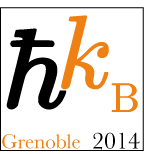Owing to light-matter interaction, the translational or vibrational degrees of freedom of a gas or a solid, at thermal equilibrium with their environment, can be either warmed up or cooled down by shining a beam of light on them. Using this principle, S. Chu C. Cohen Tannoudji and W. D. Phillips developed the so-called Doppler cooling method to optically cool down a gas of atoms (Nobel Prize 1997) [1]. Anti-Stokes (AS) fluorescence is the analogous mechanism which is currently envisaged to cool down solids. It was first proposed by Peter Pringsheim in 1929 [2]: a laser is tuned to the vibrational ground state of an electronic transition, such that most reemitted photons take away with them the energy of one or several thermal phonons. However, due to the finite probability of non-radiative recombination within solids, the method is less efficient than Doppler cooling for atom gases. So far, successful cooling down to T=155K has been achieved in Ytterbium-doped crystals [3]. More recently, cooling in semiconductor nanostructures down to T = 260K has been achieved [4]. In the latter case, the large non-radiative recombination rate of these structures was compensated by a high energy AS fluorescence, fixed by the excitonic transition.
In this work, we propose to replace light by polaritons to cool down a solid-state microcavity in the strong coupling regime. To do so, a laser injects resonantly a CW polariton field in the ground state, at k// = 0. Owing to polaritons cavity-like dispersion, Stokes fluorescence (phonon emission) is fully inhibited while AS is permitted and enhanced by the polariton's excitonic fraction. Furthermore, the effective mass of polaritons being 4 orders of magnitude smaller than that of excitons, up-converted polaritons recombine radiatively on a much larger bandwidth (27.5meV bandwidth at T=6K in this work). In this context, we investigated a Selenide-based microcavity, as it allows for (i) a polariton radiative bandwidth comparable to the mean thermal energy at room temperature, (ii) polaritons to remain stable up to elevated temperature. By carrying out angle-resolved Raman spectroscopy, we measured the cooling power generated by polariton AS fluorescence. We determine the temperature and laser power range where a net cooling rate is achievable. We show that in high-Q microcavities, the cooling rate is limited by two-photon absorption, which helps us to derive a microcavity design better fit to achieve higher cooling power.
[1] Special issue on "Laser Cooling and Trapping of Atoms", J. Opt. Soc. Am. B 6, (1989)
[2] Pringsheim, P. "Zwei Bemerkungen über den Unterschied von Lumineszenz und Temperaturstrahlung", Z. Phys. A 57, 739-746 (1929)
[3]Sheik-Bahae, M. Epstein, R. I. "Optical refrigeration" Nature Photon. 1, 693-699 (2007).
[4] J. Zhang, D. Li, R. Chen, Q. Xiong, "Laser cooling of a semiconductor by 40 kelvin", Nature 493, 504-508 (2013)

 PDF version
PDF version
